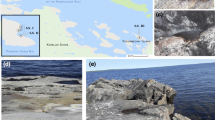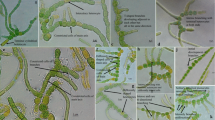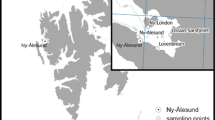Abstract
The Antarctic cyanobacterial microflora is one of the main components of the diversity of freshwater phototrophic communities in coastal areas. It is little known according to the modern taxonomic criteria (polyphasic approach). Populations of heterocytous cyanobacteria from Ulu Peninsula, the northern part of James Ross Island, NW Weddell Sea, Antarctica, were therefore reviewed. The identified morphospecies were compared with specimens from other localities in maritime Antarctica, especially from the South Shetland Islands. Ecological demands, morphological variations and, if possible, their phylogenetic positions (based on 16S rRNA gene sequencing) of registered populations were analyzed. Altogether, 11 species of heterocytous cyanoprokaryotes were recognized and studied in detail. These species were dominant in the characteristic habitats, and four novel species were described. All have a restricted endemic Antarctic distribution according to both morphology and 16S rRNA gene analyses. Three species of the genus Calothrix, one species of the genus Dichothrix (Rivulariaceae), and four species from the family Tolypotrichaceae were recognized and documented. Few species from this family belong to the recently recognized and revised genera Dactylothamnos and Hassallia, based on molecular analyses. Nodularia quadrata and two species, taxonomically classified to the genus Hydrocoryne (Nostocaceae), were studied. The complex of the genus Nostoc (especially of N. commune) exists as numerous morpho- and ecotypes, and it is diverse phylogenetically, morphologically and ecologically, and will be analyzed in special studies. Our study is important for the exact identification of cyanobacterial microflora in Antarctica, which plays a dominant role in the colonization of deglaciated areas.














Similar content being viewed by others
References
Akiyama M (1968) A list of terrestrial and subterranean algae from the Ongul-Island, Antarctica. Antarct Rec 12:71–77
Allen MM (1968) Simple conditions for growth of unicellular blue-green algae. J Phycol 4:1–3
Broady PA (1984) Taxonomic and ecological investigations of algae on steam-warmed soil in Mt. Erebus, Ross Island, Antarctica. Phycologia 23:257–271
Broady PA (1986) Ecology and taxonomy of the terrestrial algae of the Vestfold Hills. In: Pickard J (ed) Antarctic Oasis. Academy Press, Sydney, pp 165–202
Broady PA (1989) Survey of algae and other terrestrial biota at Edward VII. Peninsula, Marie Byrd Land. Antarct Sci 1:215–224
Broady PA (1996) Diversity, distribution and dispersal of Antarctic terrestrial algae. Biodivers Conserv 5:1307–1335
Broady PA (2005) The distribution of terrestrial and hydro-terrestrial algal associations at three contrasting locations in southern Victoria Land, Antarctica. Algol Stud 118:95–112
Broady PA, Given D, Greenfield L, Thompson K (1987) The biota and environment of fumaroles on Mt Melbourne, Northern Victoria Land. Polar Biol 7:97–113
Cameron RE, Devaney JR (1970) Antarctic soil algal crusts. Scanning electron and optical microscope study. Trans Am Math Soc 89:264–273
Carlson GWF (1913) Süsswasser-Algen aus der Antarktis, Süd-Georgien und den Falkland Inseln. Wissenschaftliche Ergebnisse der Schwedischen Südpolar-Expedition 1901–1903. Botanik 4:1–94
De Los Rios A, Ascaso C, Wierzchos J, Fernandez-Valiente E, Quesada A (2004) Microstructural characterization of cyanobacterial mats from the McMurdo Ice Shelf, Antarctica. Appl Environ Microbiol 70:569–580
Desikachary TV (1959) Cyanophyta. I.C.A.R. Monographs on Algae, New Delhi, pp 686
Elster J, Nedbalová L, Komárek J, Vodrážka R (2009) Biogenic calcite structures in Green Lake, James Ross Island, Antarctica. In: Barták M, Hájek J, Váczi P (eds) Structure and function of Antarctic terrestrial ecosystems. Masaryk University, Brno, pp 38–40
Elster J, Nedbalová L, Vodrážka R, Láska K, Komárek J, Řezanka T, Haloda J, Vítek P, Jehlička J (in press) Unusual biogenic calcite structures in Green Lakes, James Ross Island, Antarctica. FEMS Microbiol Ecol
Fiore MB, Alvarenga DO, Genuário DB, Andreote APD, Hauer T, Komárek J (2013) Dactylothamnos gen. nov., a novel member of Microchaetaceae isolated from extreme environments. In: Book of Abstract Internat Soc Cyanophyte Res, Cleveland, pp 22
Fritsch FE (1912) Freshwater algae. National Antarctic “Discovery” Expedition 1901–1904. Brit Mus Nat Hist 6:1–66
Geitler NL (1932) Cyanophyceae. In: Rabenhorst’s Kryptogamenflora von Deutschland, Österreich und der Schweiz, Akad Verlagsges, Leipzig, 14: 1–1196
Genuário DG, Corrêa DM, Komárek J, Fiore MF (2013) Characterization of freshwater benthic biofilm-forming Hydrocoryne isolates from Antarctica. J Phycol 49:1142–1153
Hirano M (1965) Freshwater algae in the Antarctic regions. In: van Mieghem J, van Oye P, Schell J (eds) Biogeography and Ecology in Antarctica, Monogr Biol 15: 127–193
Jungblut AD, Hawes I, Mountfort D, Hitzfeld B, Dietrich DR, Burns BP, Neilan BA (2005) Diversity within cyanobacterial mat communities in variable salinity meltwater ponds of McMurdo Ice Shelf, Antarctica. Environm Microbiol 7:519–529
Komárek J (1999) Diversity of cyanoprokaryotes (cyanobacteria) of King George Island, maritime Antarctica—a survey. Algolog Stud 94:181–193
Komárek J (2013) Cyanoprokaryota-3. Teil/3rd part: Heterocytous Genera. In Büdel B, Gärtner G, Krienitz L, Schagerl M. (eds.), Süswasserflora von Mitteleuropa (Freshwater Flora of Central Europe), Springer Spektrum Berlin, Heidelberg
Komárek J, Komárek O (2010) Diversity and ecology of cyanobacterial microflora of the seepages habitat. Comparison of King George Island, Shetland Islands, and James Ross Island, NW Weddell Sea, Antarctica. In: Seckbach J, Oren A (eds) Microbial Mats. Springer Verlag, London, pp 517–539
Komárek J, Růžička J (1966) Freshwater algae from a lake in proximity of the Novolazarevskaya Station, Antarctica. Preslia 38:237–244
Komárek J, Elster J, Komárek O (2008) Diversity of the cyanobacterial microflora of the northern part of James Ross Island, NW Weddell Sea, Antarctica. Polar Biol 31:853–865
Komárek J, Nedbalová L, Hauer T (2012) Phylogenetic position and taxonomy of three heterocytous cyanobacteria dominating the littoral of deglaciated lakes, James Ross Island, Antarctica. Polar Biol 35:759–774
Mataloni G, Tell G (2002) Microalgal communities from ornithogenic soils at Cierva Point, Antarctic Peninsula. Polar Biol 25:488–491
Nedbalová L, Nývlt D, Kopáček J, Šobr M, Elster J (2012) Freshwater lakes of Ulu Peninsula: origin, geomorphology and physical and chemical limnology. Antarct Sci 25(3):358–372
Novis PM, Smissen RD (2006) Two generic and ecological groups of Nostoc commune in Victoria Land, Antarctica, revealed by AFLP analysis. Antarct Sci 18(4):573–581
Ohtani S (1986) Epiphytic algae on mosses in the vicinity of Syowa Station, Antarctica. Mem Nat Inst Polar Res, Special Issue 44:209–219
Ohtani S, Kanda H (1987) Epiphytic algae on the moss community of Grimmia lawiana around Syowa Station, Antarctica. Proc NIPR Symp Polar Biol 1:255–264
Pandey KD, Shukla SP, Shukla PN, Giri DD, Singh JS, Singh P, Kashyap AK (2004) Cyanobacteria in Antarctica: ecology, physiology and cold adaptation. Cell Mol Biol 50:575–584
Pizarro H, Izaguirre I, Tell G (1996) Epilithic algae from a freshwater stream at Hope Bay, Antarctica. Antarct Sci 8:161–167
Prescott GW (1951) Algae of the Western Great Lakes Area. Cranbrook Inst Sci Bull 31, Bloomfield Hills, Michigan
Prescott GW (1979) A contribution to a bibliography of Antarctic and Subantarctic algae. Bibl Phycol 45:1–312
Priscu JC, Fritsen CH, Adams EE, Giovannoni SJ, Paerl HW, Mckay CP, Doran PT, Gordon DA, Lanoil BD, Pinckney JL (1998) Perrenial Antarctic Lake Ice: an oasis for life in a polar desert. Science 280:2095–2098
Strunecký O, Elster J, Komárek J (2012) Molecular clock evidence for survival of Antarctic cyanobacteria (Oscillatoriales, Phormidium autumnale) from Paleozoic times. FEMS Microbiol Ecol 82:482–490
Tamura K, Peterson D, Peterson N, Stecher G, Nei M, Kumar S (2011) MEGA5: molecular evolutionary genetics analysis using maximum likelihood, evolutionary distance, and maximum parsimony methods. Mol Biol Evol 28:2731–2739
Taton A, Grubisic S, Brambilla E, de Wit R, Wilmotte A (2003) Cyanobacterial diversity in natural and artificial microbial mats of Lake Fryxell (McMurdo Dry Valleys, Antarctica): a morphological and molecular approach. Appl Environ Microbiol 69:5157–5169
Taton A, Grubisic S, Entz D, Hodgson DA, Piccardi R, Biondi N, Tredici MR, Mainini M, Losi D, Marinelli F, Wilmotte A (2006) Polyphasic study of Antarctic cyanobacteria strains. J Phycol 42:1257–1270
West W, West GS (1911) Freshwater algae. In: Murray J (ed) British Antarctic expedition 1907–1909, Reports on the Scientific Investigations, Biology 7: 263–298
Acknowledgments
The authors are thankful to organizers of the Antarctic expeditions, in which were obtained the majority of the presented results; J. Komárek and J. Elster worked mainly at the Polish “Henryk Arctowski Station” (Admiralty Bay, King George Island) and Czech “Johann Mendel Station” on James Ross Island. D.B. Genuário participated in two Brazilian expeditions of the Brazilian Antarctic Program (PROANTAR) and received a FAPESP graduate scholarship (2010/00321-3). This study was supported as a long-term research development project no. RVO67985939, GAP506/12/1818 and by the Ministry of Education of the Czech Republic project CzechPolar LM 2010009. We would also like to thank Mrs Dana Švehlová and Jana Šnokhousová for essential technical help. English language correction was performed by Keith Edwards.
Author information
Authors and Affiliations
Corresponding author
Rights and permissions
About this article
Cite this article
Komárek, J., Genuário, D.B., Fiore, M.F. et al. Heterocytous cyanobacteria of the Ulu Peninsula, James Ross Island, Antarctica. Polar Biol 38, 475–492 (2015). https://doi.org/10.1007/s00300-014-1609-4
Received:
Revised:
Accepted:
Published:
Issue Date:
DOI: https://doi.org/10.1007/s00300-014-1609-4




